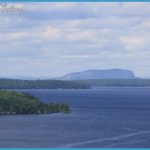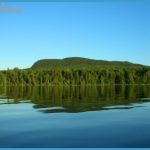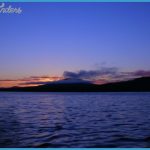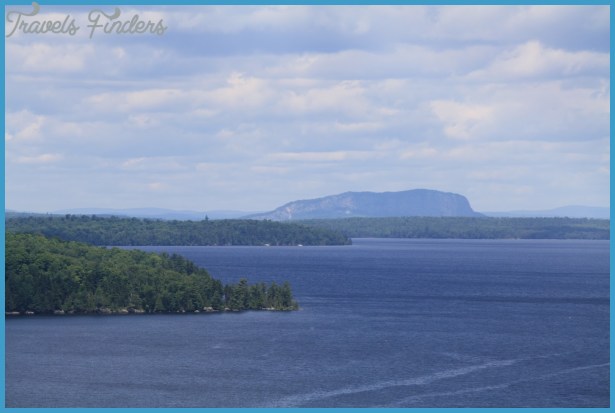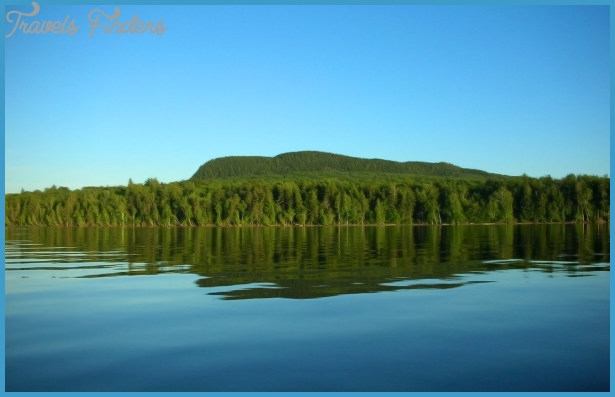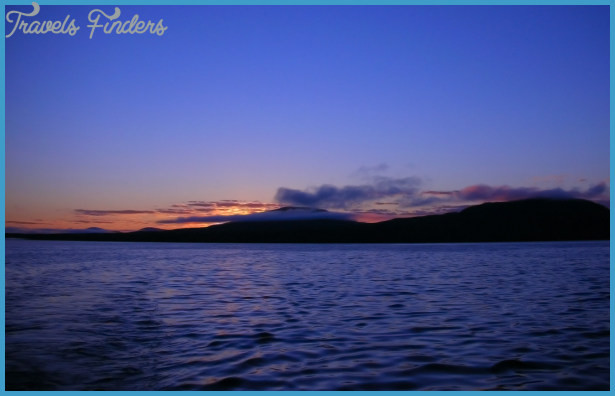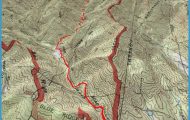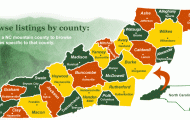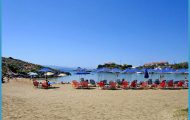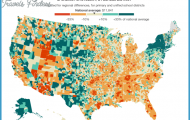Key Species: lake trout, landlocked salmon, brook trout Best Way to Fish: boat, canoe, shore Best Time to Fish: May through June MAG: 41 and 49
Description: Moosehead Lake, 30 miles long by 20 miles wide, is the largest lake contained in any one state east of the Mississippi. Here the mighty Kennebec River begins its journey to the sea. Moosehead Lake’s deep, pure water is ideal for coldwater species, which is why Maine’s three native salmonids are found here in such abundance.
You can fish from shore in many areas, but will need a boat to thoroughly explore this huge body of water. The fishing and hunting opportunities on and around Moosehead Lake have spawned a local service industry. Guide services, campgrounds, and boat and airplane trips are all available at the lake. Special fishing regulations include a slot limit on lake trout. There is camping at Lily Bay State Park and in Rockwood.
Fishing index: Anglers fishing from the pier in Greenville Junction catch landlocked salmon on spinning tackle using live bait. This is pretty much limited to the month of May. Later than May, a boat is needed because the salmon move to deeper, cooler water. It is possible to take landlocked salmon and brook trout from shore at the state boat ramp in Rockwood.
The liberal regulations on lake trout in Moosehead Lake are of special interest. The lake has so many lake trout of 18 inches and under, that they compete for food with the more popular landlocked salmon. In an attempt to rid Moosehead Lake of some of the smaller lake trout and thus balance the food chain, anglers are allowed to keep up to three lake trout a day. Only one of these lake trout may be longer than 18 inches, and all three may be between 14 and 18 inches. While you may not catch one of the 15-pound specimens for which the lake is famous, you have an excellent chance of catching good numbers of the smaller variety. If you have never taken a lake trout, a trip to Moosehead Lake is probably the easiest way to do it. The deep hole by Mount Kineo, across the lake from Rockwood, is a popular spot for lake trout as well as landlocked salmon. Troll with live smelts and a downrigger. Some anglers prefer lead-core line and a smelt or minnow fished behind a set of lake trolls. Go as slowly as possible while trolling for lake trout. It is possible to take lake trout here in May on streamer flies: gray ghost, Joe’s smelt, or Jerry’s smelt.
Use a fast-sinking fly line and a 20-foot section of 8-pound test leader. Troll slowly. This is a popular method for landlocked salmon as well, so you might pick up a salmon along the way.
Landlocked salmon are evenly distributed along the shorelines and are taken by trolling throughout the open water season. Beginning in May, local anglers prefer to troll along the shorelines with live smelt, but you can also take fish with standard tandem streamers that imitate smelt. Metal trolling spoons are also effective. Depending on how the season progresses, you should be able to pick up salmon along the shore until sometime in June. After that, you will need to fish deep, using downriggers or lead-core line, as explained earlier. Brook trout are found close to the rocky shores in May, but they move out a little deeper toward the end of June, when the water warms up. In the early season, try drifting with a night crawler, small minnow or smelt, or a Jerry’s or Joe’s smelt. You can also work the shoreline and cast toward shore with Mickey Finn bucktails, Edson tiger light bucktails, or small spinners. When the water warms and drives brook trout to deeper water, try fishing on the bottom with worms, night crawlers, or small minnows.
Although few anglers bother with them, Moosehead Lake has a huge cusk population. Most cusk are taken by ice fishers at night, but in early May, you can take pails of them near the mouth of Moose River. Use a large ice fishing jig topped with a small bit of bait, and fish it near the bottom. Sometimes big lake trout hit these cusk jigs, so be prepared.
Directions: From Monson take Maine Routes 6 and 15 north to Greenville, at the south end of Moosehead Lake. In Greenville, you have several options. Lily Bay State Park offers two boat ramps and camping. To get to Lily Bay, go straight ahead at the 4-way intersection in Greenville and follow the Lily Bay Road north. Watch for signs for Lily Bay State Park on the left. A new state boat ramp at Rockwood offers access to the upper reaches of the lake. To get to Rockwood, turn left at the 4-way intersection in Greenville and follow Maine Routes 6 and 15 north to Rockwood. The boat ramp is on the left.
For more information: Contact the Moosehead Lake Vacation and Sportsmen’s Association; the Greenville Chamber of Commerce; or the Maine Department of Inland Fisheries & Wildlife Regional Office in Greenville.
A public boat launch at Rockwood, on Moosehead Lake, with the sheer cliffs of Mt. Kineo in the background. Such facilities provide access to dozens of Maine’s fabled fishing waters.
West Branch Penobscot River, Ripogenus Dam to Abol Falls Key Species: landlocked salmon, brook trout Best Way to Fish: canoe, wading Best Time to Fish: June MAG: 50, D-3
Description: The West Branch of the Penobscot is a brawling river with falls, whitewater, and deep pools. Roads and paths border the river. This is Maine’s premier trophy landlocked salmon river. Fishing regulations vary on different sections of the river, so check the Open Water Fishing Regulations booklet before fishing. Wading and bank fishing are both possible at this site. You can easily launch a canoe at Nesowadnehunk Deadwater, a wide and calm section of the river. There are campsites at Big Eddy, Nesowadnehunk Deadwater, and Abol Falls. You can find motels in Millinocket, a 45-minute drive from the river.
Fishing index: The West Branch of the Penobscot River below Ripogenus Dam contains bigger landlocked salmon than any other river in the country. June is the best month for fishing, but the always-cool water keeps salmon active throughout the open water season. Smelt imitations are most effective in May and June. The gray ghost, Maine’s old standard streamer fly, is effective here, as are all the standard bucktails and streamers. You should have a 9-foot fly rod of at least 6-weight. Fill your reel with plenty of backing, since it is possible to hook a landlocked salmon of up to 8 pounds. If the water is at all high, you can get by with a 3-pound tippet.
Dry-fly anglers should use large attractor patterns when no insects are showing. In summer, caddis hatches are the key to success, so bring plenty of caddis imitations. Soft-hackle flies are often killers on this river. Always keep a few soft-hackles in your fly box. The West Branch special is a popular Maine pattern and is highly effective on the West Branch. The dressing for a West Branch special, to be fished wet, is as follows: size 12 hook, dark brown dubbing, wing of reddish-tinted mallard body feather, tied sparse, and a few winds of a soft, brown hackle from a hen neck.
When wading this brawling river, be especially careful of rising water. Always keep an avenue of escape open. Felts and grippers will be a great help.
Big and wild, the West Branch of the Penobscot River lies in the heart of Maine’s unspoiled north country. This classic water holds trophy-sized brook trout and landlocked salmon, and is a prime destination for fly-fishers from around the country.
Directions: Roads leading to the West Branch of the Penobscot River are part of the North Maine Woods Multiple Ownership-Multiple Use Management Area. From Maine Route 15 and 6, in Greenville, take the Lily Bay Road north to Kokadjo. From there, head north on the Sias Hill Road, to the Sias Hill Checkpoint, where you must stop and register.
Continue north, following signs for Ripogenus Dam and go straight to the Greenville Road. Follow the Greenville Road to the intersection of the Golden Road and turn right, at the south end of Caribou Lake. Continue on the Golden Road and turn left at the checkpoint for Ripogenus Lake, where you will find a boat ramp and campsite. It is 42 miles from Greenville to Ripogenus Dam. The river, from below the dam to Abol Falls, a distance of about 10 miles, is bounded by the Golden Road, which provides almost unlimited access. An alternative route would be to take Interstate 95 to Exit 56 in Medway and from there, take Maine Routes 157 and 11 west to Millinocket. From Millinocket, take the Golden Road to the West Branch.
For more information: For a campsite reservation, contact the North Maine Woods office. You should request one of their pamphlets. It is strongly recommended that you purchase a map of the area. Great Northern Paper publishes a detailed map of the region, cost $3. You can pick one up at the checkpoint or contact Great Northern Paper. If you plan to stay at different sites in the general area, call the Northern Region Headquarters in Island Falls for fire permit information 7 days a week. Many campsites along the West Branch of the Penobscot River are under the jurisdiction of the Maine Bureau of Parks and Recreation.

